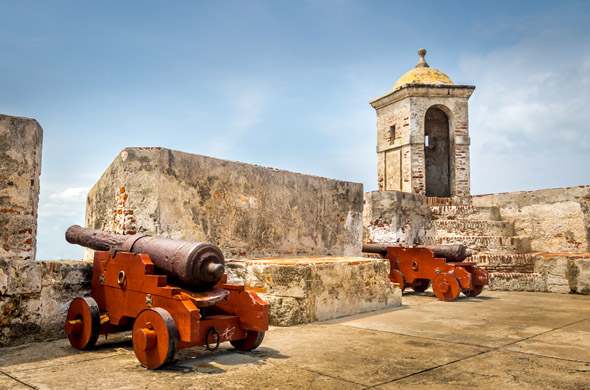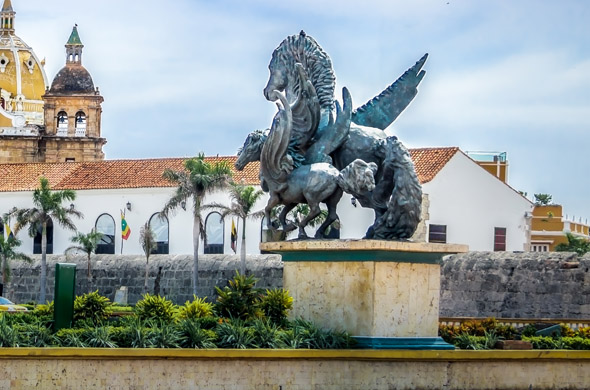Cartagena de Indias: A Journey Through History
- Grupo Bora Bora
- Noticias
- 0 likes
- 4122 views
- 0 comments

Located on the Caribbean coast of Colombia, Cartagena de Indias is a city that invites travelers to immerse themselves in a rich and fascinating history. Founded in 1533 by the Spanish conquistador Pedro de Heredia, Cartagena has witnessed crucial events that have shaped its character and beauty. This article will take you on a tour of the most notable moments in the history of Cartagena, revealing why this city is a must-see destination.
The Foundation and the Colonial Rise
From its beginnings, Cartagena de Indias stood out as an important colonial port. Its strategic location made it a crucial point for trade between the New World and Europe. Treasures from South America, including gold and silver, passed through its port, attracting the attention of pirates and privateers.
To protect itself from constant attacks, the city began to be fortified in the 16th century. The result was an impressive system of walls and fortifications that today constitutes one of the most complete sets of colonial military architecture in South America. The Castle of San Felipe de Barajas, one of the most imposing fortresses, stands as a witness to Cartagena's resistance against multiple invasion attempts.

During the 17th and 18th centuries, Cartagena was also a key center of the slave trade. Thousands of Africans were brought to its shores and sold as slaves, a dark but pivotal chapter in the city's history. This legacy is evident in the vibrant Afro-Caribbean culture that enriches Cartagena's identity today.
At the beginning of the 19th century, Cartagena became a bastion of the independence movement in Colombia. In 1811, the city was one of the first to declare its independence from Spain. However, this decision brought with it fierce retaliation by colonial forces, resulting in the Siege of Cartagena in 1815. Despite the devastation, the city finally managed to liberate itself in 1821, cementing its role in the history of Colombian independence. .
In 1984, UNESCO recognized the historical and cultural importance of Cartagena de Indias, declaring its historic center as a World Heritage Site. Cobblestone streets, colorful colonial facades and historic churches, such as the Cathedral of Saint Catherine of Alexandria and the Church of Saint Peter Claver, transport visitors to bygone eras.

Cartagena Today
Today, Cartagena is a vibrant tourist destination that offers a unique blend of history, culture and natural beauty. In addition to its impressive historical legacy, the city has dream beaches, delicious cuisine and lively nightlife. Modern neighborhoods, such as Bocagrande and Getsemaní, contrast with the Walled City, offering visitors a variety of experiences.
Exploring Cartagena de Indias is taking a journey through time. Every corner of this Caribbean city has a story to tell, from its centuries-old fortresses to its cultural festivals. Come and discover why Cartagena is a treasure of history and culture, waiting to be explored.
Spanish architectural heritage is reflected in Cartagena as one of the most beautiful cities in the New World. The Ancient City is surrounded by bastions, structures similar to the walls but without their height, polygonal in shape, which were built so that in the event of a foreign invasion or looting the city could defend itself and protect its riches. What is known today as the Walled City began its construction before approximately the year 1600 and was completed in 1796 by the engineer Antonio de Arévalo.
Before the arrival of the Spanish, and although it is known that the indigenous people were polytheistic, there is very little information regarding religion, since they did not have a written language and The Spanish chroniclers did not delve into it, so in relation to religious customs reference is made to those of the Mayans, since by inheritance, these are the predecessors of the indigenous tribes settled in what is today Cartagena de Indias. Currently, the predominant religion in the city of Cartagena is Catholicism. When the Spanish arrived in the city, they built different temples that have made the "Walled City" a religious destination often visited by different parishioners from other nations. Some of the most recognized churches in the city are San Pedro Claver, Santo Domingo, San Roque, Trinidad, among others.
Currently, the predominant religion in the city of Cartagena is Catholicism. When the Spanish arrived in the city, they built different temples that have made the "Walled City" a religious destination often visited by different parishioners from other nations. Some of the most recognized churches in the city are San Pedro Claver, Santo Domingo, San Roque, Trinidad, among others.

comments (0)